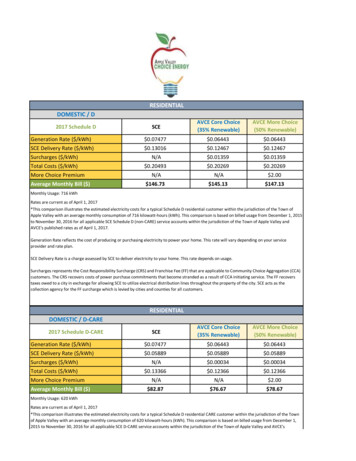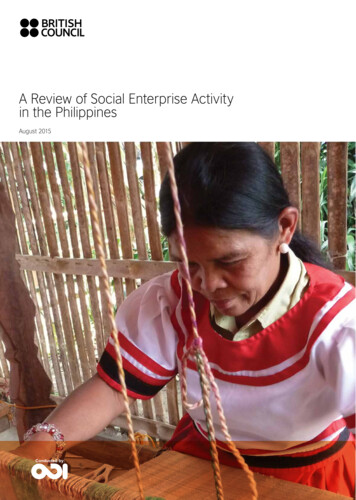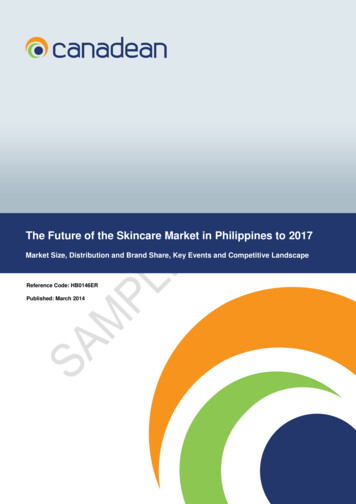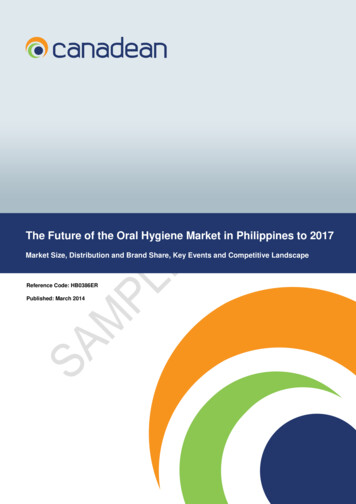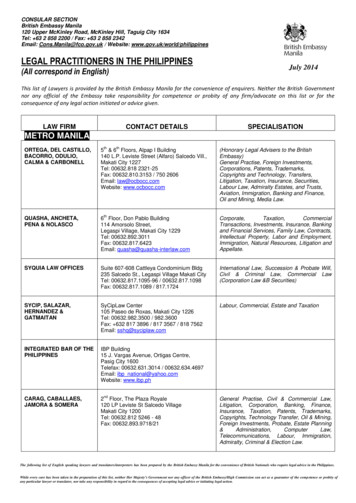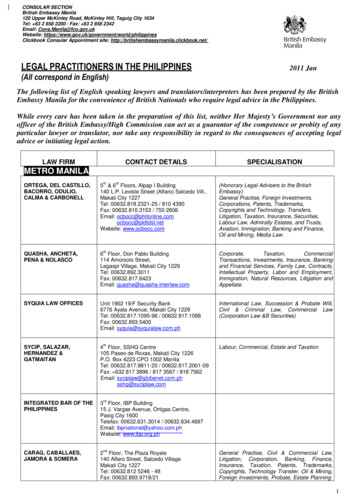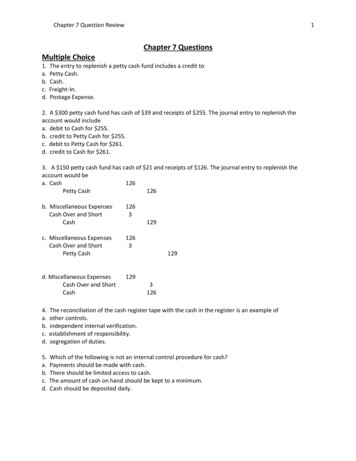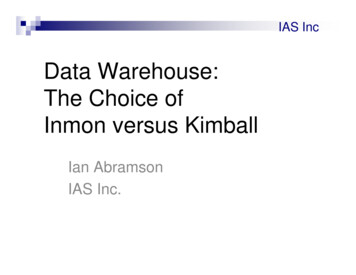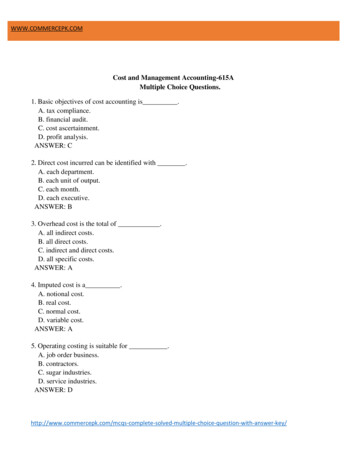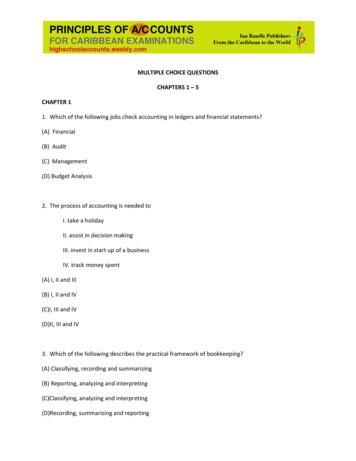
Transcription
COLLEGE CHOICE IN THE PHILIPPINESChristine Joy Tan, B.A., B.B.A., TH.M.Dissertation Prepared for the Degree ofDOCTOR OF PHILOSOPHYUNIVERSITY OF NORTH TEXASMay 2009APPROVED:Ron W. Newsom, Major ProfessorMichael S. Lawson, Minor ProfessorPatsy Fulton-Calkins, Committee MemberKathleen Whitson, Program Coordinator forHigher EducationJan Holden, Chair of the Department ofCounseling and Higher EducationJerry Thomas, Dean of the College ofEducationMichael Monticino, Interim Dean of the RobertB. Toulouse School of Graduate Studies
Tan, Christine Joy. College Choice in the Philippines. Doctor of Philosophy(Higher Education), May 2009, 226 pp., 33 tables, 4 figures, references, 109 titles.This descriptive and correlational study examined the applicability of major U.S.college choice factors to Philippine high school seniors. A sample of 226 students froma private school in Manila completed the College Choice Survey for High SchoolSeniors. Cronbach's alpha for the survey composite index was 0.933. The purposes ofthis nonexperimental, quantitative study were (1) to describe the relative importance ofmajor college choice factors (as identified in U.S. research) to Philippine high schoolseniors, and (2) to determine whether there were statistically significant differences inthe importance ascribed to these factors, according to students’ demographic attributes.For all statistical analyses, SPSS 16.0 software was used. To address the firstpurpose, the mean and standard deviation were calculated for each college choicefactor addressed in the survey. To address the second purpose, ANOVAs, MannWhitney U tests, and Kruskal-Wallis tests were run, in order to study the relationshipbetween each of the major college choice factors and students’ demographic attributes.This study found that all of the major U.S. college choice factors were important,to some degree, in the Philippine context. Other factors were added based on pilotstudies. This study also found that some of the U.S.-literature-generated demographicchoice attributes functioned similarly in the Philippine setting (e.g. academic ability,gender), while others did not (e.g. educational level of fathers and of mothers).Moreover, students’ academic ability was the primary demographic attribute, accountingfor statistically significant differences in assessment of the importance of college choicefactors for most (12 out of 13) of the factors.
The major U.S. college choice factors appear to be important to Philippine privatehigh school students. Two choice attributes (academic ability, gender) appear to applyto private high school students in the Philippines, while the attributes of father's andmother's education levels do not appear to apply. Among Philippine private high schoolstudents, academic ability may account for differences in assessment of the importanceof college choice factors. Using a survey method alone to study college choice islimiting. Future studies should utilize a variety of methods to collect data and shouldinvolve several schools.
Copyright 2009byChristine Joy Tanii
ACKNOWLEDGEMENTSTo my Lord and Savior Jesus Christ, I give all glory, honor, and praise!“Looking unto Jesus the author and finisher of our faith ” (Hebrews 12:2)I would like to express sincere appreciation to Dr. Ron Newsom, my majorprofessor, for his wise guidance, graciousness, and patience throughout thisdissertation process. Many thanks to Dr. Michael Lawson and Dr. Patsy Fulton-Calkinsfor sharing their excellent insights.My beloved parents (Dr. and Mrs. Paul Lee Tan) and family have been aconstant source of unconditional love, encouragements, and support.Special thanks to Dr. and Mrs. James L. Tan, with respective administrators, forpermission and aid in administering the surveys.My church family and friends have been my “cheerleaders” during this doctoralmarathon. Thanks so much.iii
TABLE OF CONTENTSPageACKNOWLEDGEMENTS .iiiLIST OF TABLES .xLIST OF FIGURES .xiiChapter1.INTRODUCTION . . .1Statement of the Problem . .2Purposes of the Study .2Research Questions .3Significance of the Study .5Definition of Terms 6Definition of Terms (Relating to Philippine Higher Education) 10Limitations 11Delimitations 12Assumptions 122.LITERATURE REVIEW .13Introduction . 13Proposed Models of College Choice . 13Econometric Models of College Choice. 14Status-Attainment Models of College Choice . .15Information-Processing Models of College Choice . 16Combined Models of College Choice . 17Jackson’s Three–Phase Model (1982) 17Litten’s Five–Phase Model (1982) .18Hossler & Gallagher’s Three-Phase Model (1987).19Predisposition . 20Search . .22Choice .23iv
Hossler and Gallager (1987) Model asResearch Organizing Framework 24Factors Influencing College Choice . 24Student Characteristics .26Academic Ability .26Socioeconomic Status .29Race/Ethnicity . .33High School Environment .42Educational Aspirations/Expectations. .46Gender .47Institutional Characteristics . 51Academic Quality . .51Programs of Study .54Cost and Financial Aid .56Location 63Social Atmosphere .67Future Job Opportunities. 69Religious Emphasis . .70Significant Others . . .73Parents . 73Guidance Counselors 83Friends . 86College/University Search Activities: College Marketing.87Connection of Factors with Survey . .92Philippine Higher Education and College Choice Research . 96Background . . 96The Philippines . 96The Educational System . . 97Elementary and Secondary Education . 97Post-Secondary Technical andVocational Education .98v
Higher Education in the Philippines: A General Overview.98Historical Milestones . 98Spanish Colonization (1521-1898) . . 98American Period (1898-1946) . . . 99Post-World War II . . .1001969—Beginning of Regulation . .1001992—Deregulation .100The Results of a Laissez-Faire Policy . 101The Commission on Higher Education (CHED) .101Some Current Aspectsof Philippine Higher Education . 102Distribution of Institutional Types . . 102Enrollment in Higher Education . 104Predominance ofUndergraduate Enrollment .106Entry Level . 107Socioeconomic Statusand College Choice . 108Scholarships and Other Student AssistancePrograms . 109Commuter Institutions .111Student Services . 112Accreditation of Higher Education .112Professional Board Examinations . . 113Lack of Research . 113Attitudes Towards Higher Education . 114Review of College Choice Research in the Philippines. 115Application of U.S. College Choice Research to the Philippines.117The Western Impact on Higher Educationin the Philippines . 117Logic for Applying United States Researchto the Philippine Situation 120vi
Findings Relate to Search and Choice Phases . 120Summary 1223.RESEARCH METHODOLOGY. . 124Theoretical Framework 124Research Design . .125Procedure for Data Collection 126Study Setting .127Study Population . 128Institutional Review Board .129Survey Instrument 129Validity and Reliability of the Survey Instrument .134Survey Validity . 134Survey Reliability . 135Cronbach’s Alpha for Pilot Survey . .136Cronbach’s Alpha for Final Survey . .136Data Analysis 1374.FINDINGS . 139Introduction 139Demographic Profile of Students . . 139Missing Values in the Data Set . .140Research Questions Addressed 141Research Question 1 . 141Research Question 2 . . 142Meeting the Assumptions of ANOVA 144Random and Independent Samples . 144Normal Distribution ofDependent Variables . .144Homogeneity of Variance 146Balanced Design . 147Effect Sizes Used . 148vii
Research Question 2.1 149Research Question 2.2 161Research Question 2.3 . .165Research Question 2.4 165Research Question 2.5 167Research Question 2.6 . .168Research Question 2.7 . .169Research Question 2.8 . .169Research Question 2.9 . .171Research Question 2.10 . 171Additional Findings .1725.SUMMARY OF FINDINGS, DISCUSSION, CONCLUSIONS ANDRECOMMENDATIONS . 173Summary and Discussion of Findings . 173Introduction 173Research Question 1 . 174Research Question 2 .176Research Question 2.1 176Research Question 2.2 178Research Question 2.3 178Research Question 2.4 180Research Question 2.5 181Research Question 2.6 181Research Question 2.7 182Research Question 2.8 183Research Question 2.9 184Research Question 2.10 .185Additional Finding . 185Conclusions .186Implications 186viii
Recommendations .188Personal Reflections on Conducting International Research 189AppendicesA.INSTITUTIONAL REVIEW BOARD APPROVAL LETTER . .190B.INFORMED CONSENT AND STUDENT ASSENT FORMS . .192C.PILOT SURVEY EVALUATION FORM .195D.SURVEY INSTRUMENT .197E.INFORMATION TABLES .201F.STUDENT CHARACTERISTICS AND INSTITUTIONAL PRACTICE .207REFERENCES .218ix
LIST OF TABLESPage1.College Choice Factors and Survey Questions .922.Distribution of Higher Education Institutions by Sector and Institutional Type,AY 2004-2005 .1043.Enrollment by Sector, Institutional Type and Sex, AY 2004-2005 1064.Enrollment by Sector, Institutional Type and Program Level, AY 2004-2005 1075.Beneficiaries of CHED’s Student Financial Assistance Programs,AY 2004-2005 .1116.College Choice Factors and Survey Questions .1307.College Choice Factors: Mean and Standard Deviation 1428.Selected College Choice Factors (Dependent Variables):Skewness and Kurtosis .1459.Skewness and Kurtosis: Before and After Data Transformation .14610.Cohen's (1988) benchmarks for effect size magnitudes 14911.Analysis of Variance for Academic Ability (Honors vs. Non-Honors) andAcademic Quality .15012.Analysis of Variance for Academic Ability (Honors vs. Non-Honors) andPrograms of Study 15113.Analysis of Variance for Academic Ability (Honors vs. Non-Honors) andCost and Financial Aid .15214.Analysis of Variance for Academic Ability (Honors vs. Non-Honors) andLocation .15315.Analysis of Variance for Academic Ability (Honors vs. Non-Honors) andSocial Atmosphere .15416.Analysis of Variance for Academic Ability (Honors vs. Non-Honors) andParents .15617.Analysis of Variance for Academic Ability (Honors vs. Non-Honors) andGuidance Counselors .157x
18.Analysis of Variance for Academic Ability (Honors vs. Non-Honors) andFriends .15819.Analysis of Variance for Academic Ability (Honors vs. Non-Honors) andPastor/Religious Adviser . .15920.Analysis of Variance for Academic Ability (Honors vs. Non-Honors) andCollege Marketing 16021.Analysis of Variance for Academic Ability (Overall High School Average) andSocial Atmosphere .16222.Analysis of Variance for Academic Ability (Overall High School Average) andReligious Emphasis .16323.Analysis of Variance for Academic Ability (Overall High School Average) andFriends .16424.Analysis of Variance for Academic Ability (Overall High School Average) andPastor/Religious Adviser .16525.Analysis of Variance for Gender and College Marketing .16626.Analysis of Variance for Educational Aspirations/Expectations andPrograms of Study 16827.Analysis of Variance for Race/Ethnicity and Cost and Financial Aid .16928.Analysis of Variance for Mother's Educational Level and Social Atmosphere.17029.Responses to Survey Question 42 17230.Responses to Survey Question 45 172E.1Demographic Characteristics of Student Respondents .202E.2College Choice Factors (Dependent Variables) and Survey Questions .204E.3Demographic Factors (Independent Variables) and Survey Questions .206xi
LIST OF FIGURESPage1.Hossler & Gallager’s Three-Phase Model of College Choice (1987) .192.Predisposition (Phase 1) .213.Search (Phase 2) 224.Choice (Phase 3) 23xii
CHAPTER 1INTRODUCTIONThe crucial significance of the college choice decision to a person’s life andfuture cannot be overstated (Canterbury, 1999, p. 26). According to Boyer (1987), “inchoosing a college, one of life’s major decisions is being made. A lot of time, money,and effort will be involved. The shape and quality of the student’s life may rest on theoutcome” (p. 287).Research on college choice has provided additional insights in this area. Yet, asLiu (2005) and others have observed, “Most of the studies in college choice wereconducted in the United States and other Western countries like Australia . . . and someEuropean countries” (p. 18). The reality is that research on the college choice ofstudents in the Philippines is limited. College choice research also has implications forthe recruiting strategies of colleges/universities. Paulsen (1990) writes,The most important contribution of the micro-level studies of individual studentenrollment behavior is their ability to estimate the effects of studentcharacteristics, institutional characteristics, and their interactions on theprobability that a student will choose a particular college or noncollege option. . . .Understanding the probable enrollment effects of institutional characteristics canhelp faculty and administrators develop the most appropriate marketing mix ofattractive programs, delivered in appropriate places, at acceptable prices. (pp.73-74)1
Statement of the ProblemA major high school in the Philippines had recently launched into the highereducation arena, by starting its own college. The aim was to recruit half of its collegestudents from its high school base. As competition from area colleges/universities wasstiff, administrators of the fledgling college needed an understanding of what their highschool seniors were looking for in terms of higher education institutions. Unfortunately,research focused on the college choice of students in the Philippines was limited. Abetter understanding of how high school seniors evaluated the relative importance ofmajor college choice factors would aid this college in recruiting students from its highschool base.Purposes of the StudyThe first purpose of this study was to describe the relative importance of majorcollege choice factors (as identified in United States research) to high school seniors inthe Philippines, who were in the search and choice phases of their college selectionprocess. The second purpose was to determine whether there were statisticallysignificant differences in the relative importance ascribed to these major college choicefactors (i.e. academic quality, college marketing, cost and financial aid, friends,guidance counselors, future job opportunities, location, parents, pastor/religious adviser,programs of study, religious emphasis, security, and social atmosphere), according todemographic attributes of the students (i.e. academic ability, socioeconomic status,gender, educational aspirations/expectations, race/ethnicity, father’s educational level,mother’s educational level, religion, and friends/peer influence).2
Research QuestionsThe study sought answers to these research questions:RQ1: How do high school seniors in the Philippines, in the search and choicephases of their college selection process, evaluate the relative importance of majorcollege choice factors (as identified in United States research)?RQ2: Do the relative importance ascribed to these major college choice factors(i.e. academic quality, college marketing, cost and financial aid, friends, guidancecounselors, future job opportunities, location, parents, pastor/religious adviser,programs of study, religious emphasis, security, and social atmosphere) vary when thesurvey population was disaggregated by students’ demographic attributes (i.e.academic ability, socioeconomic status, gender, educational aspirations/expectations,race/ethnicity, father’s educational level, mother’s educational level, religion, andfriends/peer influence)?RQ2.1: Is there a statistically significant difference in the relative importanceascribed to these major college choice factors, when the survey population wasdisaggregated by students’ academic ability (as distinguished by being in honors versusnon-honors class section)?RQ2.2: Is there a statistically significant difference in the relative importanceascribed to these major college choice factors, when the survey population wasdisaggregated by students’ academic ability (as seen in overall high school average)?RQ2.3: Is there a statistically significant difference in the relative importanceascribed to these major college choice factors, when the survey population wasdisaggregated by students’ socioeconomic status?3
RQ2.4: Is there a statistically significant difference in the relative importanceascribed to these major college choice factors, when the survey population wasdisaggregated by students’ gender?RQ2.5: Is there a statistically significant difference in the relative importanceascribed to these major college choice factors, when the survey population wasdisaggregated by students’ educational aspirations/expectations?RQ2.6: Is there a statistically significant difference in the relative importanceascribed to these major college choice factors, when the survey population wasdisaggregated by students’ race/ethnicity?RQ2.7: Is there a statistically significant difference in the relative importanceascribed to these major college choice factors, when the survey population wasdisaggregated by students’ father’s educational level?RQ2.8: Is there a statistically significant difference in the relative importanceascribed to these major college choice factors, when the survey population wasdisaggregated by students’ mother’s educational level?RQ2.9: Is there a statistically significant difference in the relative importanceascribed to the college choice factor of religious emphasis, when the survey populationwas disaggregated by students’ religion?RQ2.10: Is there a statistically significant difference in the relative importanceascribed to these major college ch
COLLEGE CHOICE IN THE PHILIPPINES Christine Joy Tan, B.A., B.B.A., TH.M. Dissertation Prepared for the Degree of DOCTOR OF PHILOSOPHY UNIVERSITY OF NORTH TEXAS May 2009 APPROVED: Ron W. Newsom, Major Professor Michael S. Lawson, Minor Professor Patsy Fulton-Calkins, Committee Member Kathleen Whitson, Program Coordinator for Higher EducationAuthor: Christine Joy Tan
